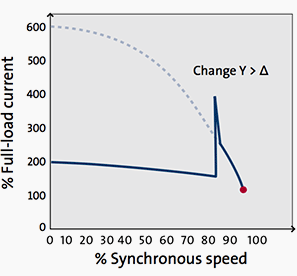Motor starting methods
Direct-on-line starting (DOL)
As the name suggests, direct-on-line starting means that the motor is started by connecting it directly to the supply at rated voltage. Direct-on-line starting, (DOL), is suitable for stable supplies and mechanically stiff and well-dimensioned shaft systems – and pumps qualify as examples of such systems.
 | ||||
| Line diagram for Direct-on-line motor starting |
Where:
- K1 – Main contactor
- MV1 – Overload relay
Advantages of DOL
DOL starting is the simplest, cheapest and most common starting method. Furthermore it actually gives the lowest temperature rise within the motor during start up of all the starting methods.
It is the obvious choice wherever the supply authority’s current limiting restrictions allow for its use.
Power plants may have varying rules and regulations in different countries. For example:Three-phase motors with locked-rotor currents above 60 A must not use direct-on-line starting in Denmark. In such cases, it will obviously be necessary to select another starting method.
Motors that start and stop frequently often have some kind of control system, which consist of a contactor and overload protection such as a thermal relay
 |
| DOL curve – Synchronous speed / Full-load torque |
.
Drawbacks of DOL
Small motors which do not start and stop frequently need only very simple starting equipment, often in the form of a hand-operated motor protection circuit breaker.
Full voltage is switched directly onto the motor terminals. For small motors, the starting torque will be 150% to 300% of the full-load value, while the starting current will be 300% to 800% of the full-load current or even higher.
 |
| DOL curve – Synchronous speed / Full-load current |
Star-delta starting
The objective of this starting method, which is used with three-phase induction motors, is to reduce the starting current.
In starting position, current supply to the stator windings is connected in star (Y) for starting. In the running position, current supply is reconnected to the windings in delta (∆) once the motor has gained speed.
 |
| Line diagram for star-delta motor starter |
Advantages of Y-Δ
Normally, low-voltage motors over 3 kW will be dimensioned to run at either 400 V in delta (∆) connection or at 690 V in star (Y) connection. The flexibility provided by this design can also be used to start the motor with a lower voltage. Star-delta connections give a low starting current of only about one third of that found with direct-on-line starting.
Star-delta starters are particularly suited for high inertias, where the load are initiated after full load speed.
 |
| Start-delta starter curve – Synchronous speed / Full-load torque |
But they also reduce the starting torque to about 33%. The motor is started in Y-connection and accelerated and switched to the star-delta connection. This method can only be used with induction motors that are delta connected to the supply voltage.
- If the changeover from star to delta takes place at too low a speed, this can cause a current surge which rises almost as high as the corresponding DOL value. During the even small period of switch over from start to delta connectionthe motor looses speed very rapidly, which also calls for higher current pulse after connection to delta.
 |
| Star-delta starter curve – Synchronous speed / Full-load current |
Starting torque and current are considerably lower at star-delta starting than at direct-on-line starting: one third of the equivalent DOL value.
Mismatching of motor torque speed curve and load torque speed curve. In the example shown here, the motor would slowly accelerate up to approximately 50 per cent rated speed.
 |
| Mismatching of motor torque speed curve and load torque speed curve |
Comparision of DOL and Star-delta starting
The following graphs illustrate currents for a Grundfos CR pump started with a Grundfos MG 7.5 kW motor by means of DOL and star-delta starting, respectively. As you will see, the DOL starting method features a very high locked-rotor current which eventually flattens and becomes constant.
 |
| Direct-on-line starting of a Grundfos 7.5 kW motor installed on a Grundfos CR pump |
The star-delta starting method features a lower locked-rotor current, but peaks during the starting process as the changeover from star to delta is made.
When starting in star (t = 0.3 s), the current is reduced.
 |
| Star-delta starting of a 7.5 kW Grundfos motor installed on a Grundfos CR pump |
However, when switching over from star to delta (at t = 1 .7 s), the current pulse reaches the same level as the locked-rotor current seen with direct-on-line starting. The current pulse can even get higher, because the motor during the switching period is un-powered which means it reduce speed before the full voltage (delta voltage) are supplied.






























Hi, I'm Edvard CSANYI, an author of technical articles and pages you blatantly stole from EEP - Electrical Engineering Portal.
ReplyDeleteNow, you have 24 hours to remove all of EEP's article including stolen images, or I will be forced to complain to your hosting (Blogspot) and this can directly lead to terminating of your website.
You must remove ALL EEP's content, not just images. Again, take it very seriously, or I will fill the GOOGLE DMCA copyright report for Blogger. This is the first and the last warning, please take it seriously. Your website is being monitored.
Thank you.
Edvard CSANYI
Owner of EEP - Electrical Engineering Portal